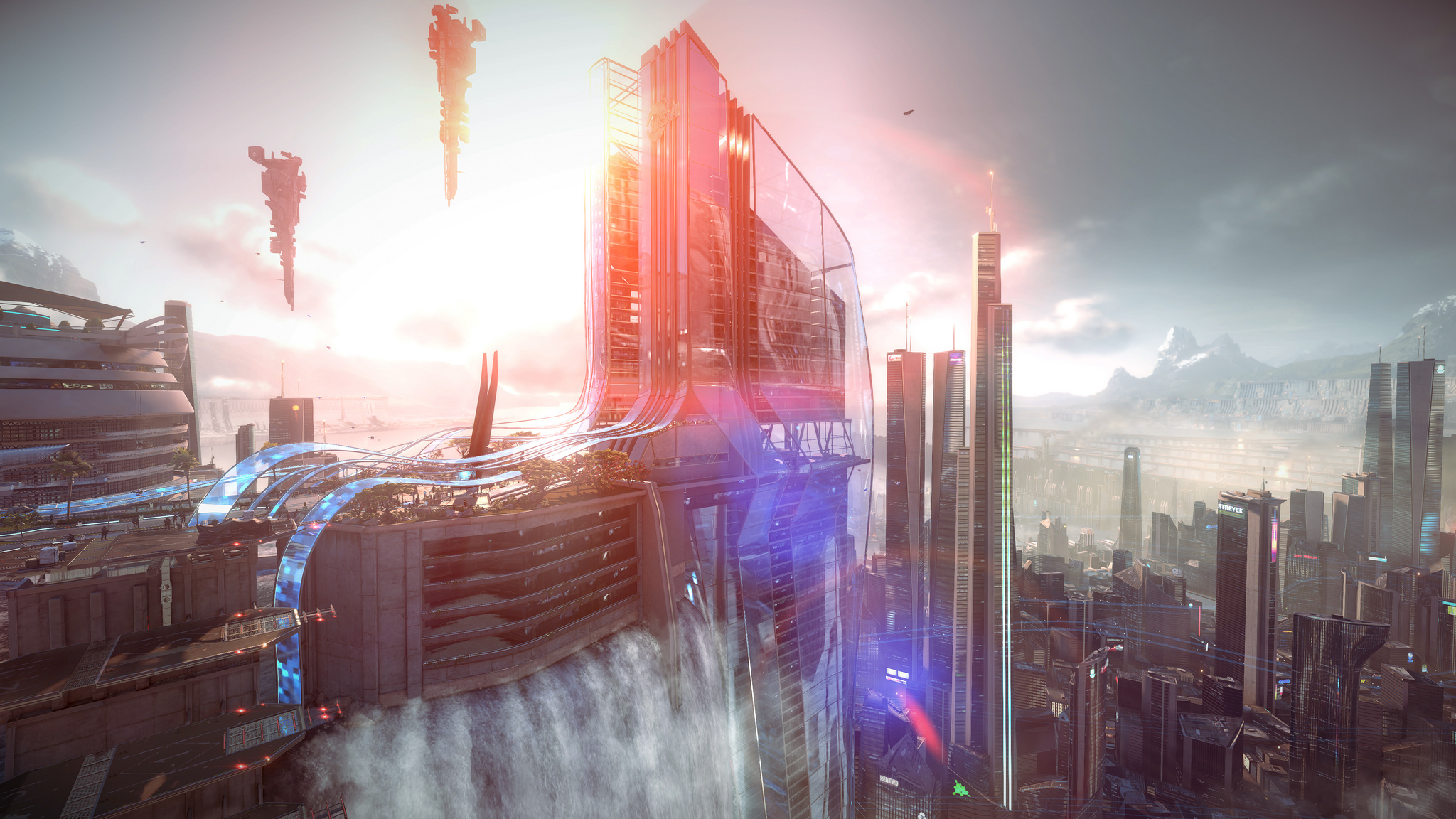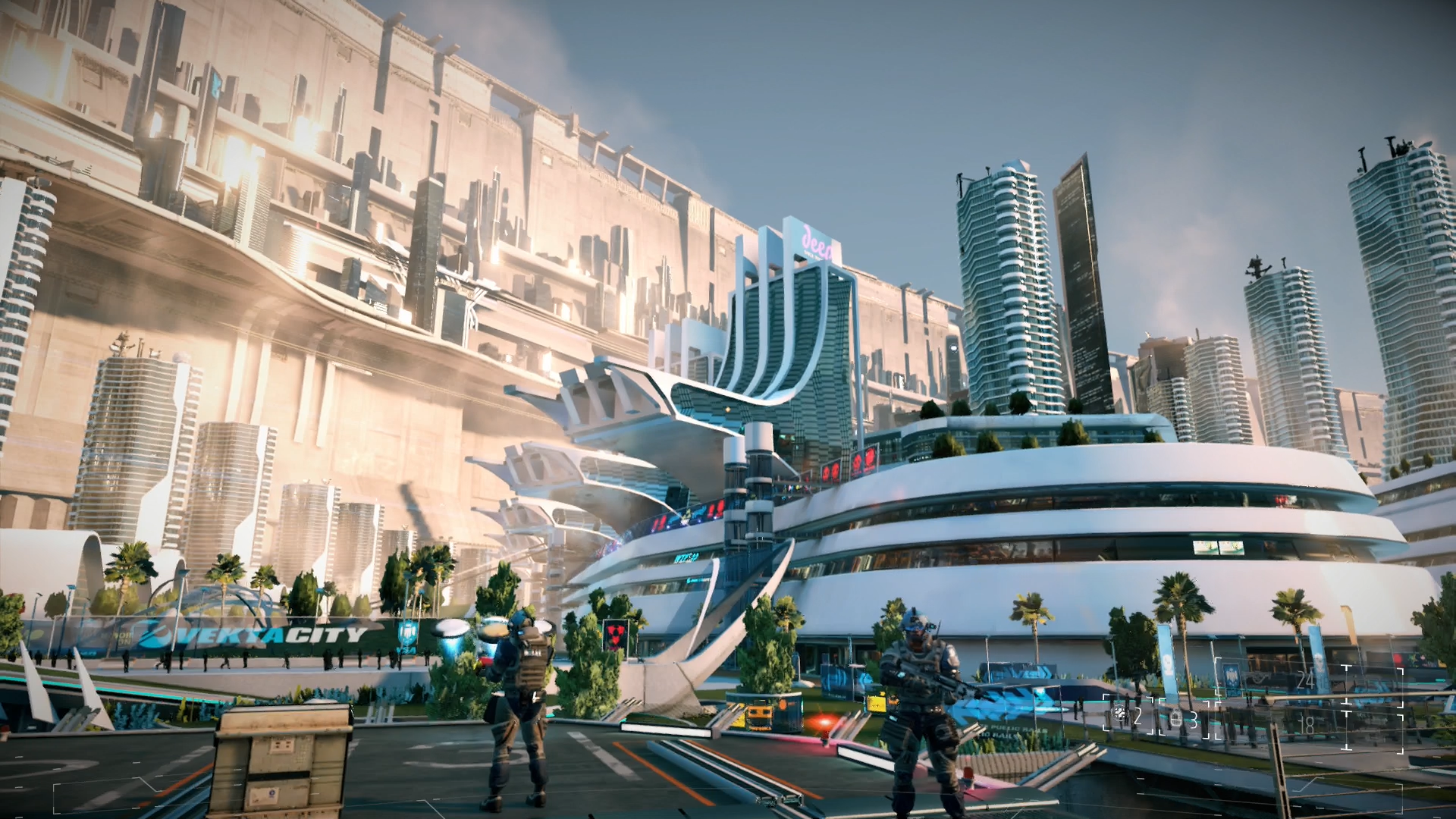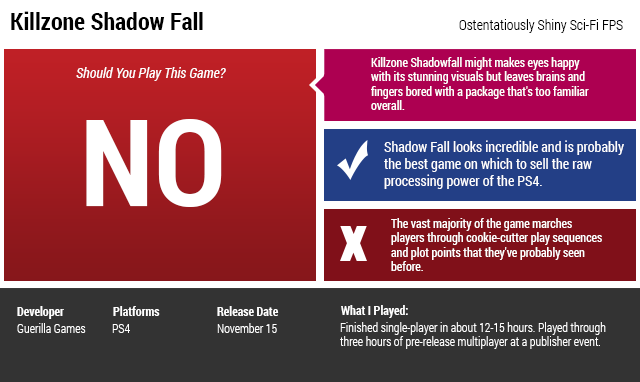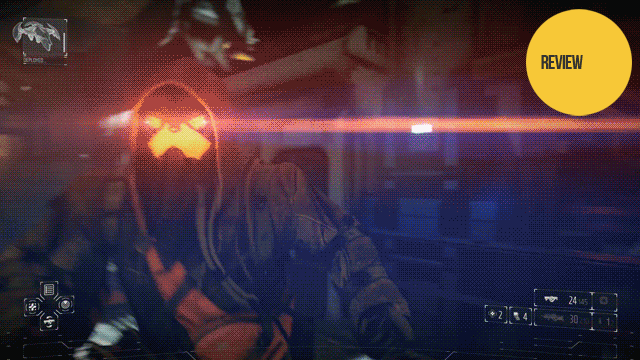One thought ran through my head while playing Killzone Shadow Fall: How beautiful can a cliché look?
It’s no surprise that Shadow Fall is beautiful. The Killzone games that showed up on the PS2 and PS3 offered up some of the best graphics ever seen on those consoles. So, yes, the opening hours of this PS4 title — and many portions that follow — are eye candy of the highest order. Blooming light that dapples through obstacles in sexy hyper-realism. Dust so articulated you’ll feel your nose itch. Randomised rain that will make you shiver.

Yet, for all their tech prowess, Guerilla Games haven’t ever really made a title where the storytelling matched the engineering. They try to do that here — with a story that echoes the Cold War — but don’t quite get there.
Shadow Fall takes place decades after the end of Killzone 3 and finds the remnants of the Helghast — the series’ totalitarian space villains — sharing planet Vekta with their hated racial cousins. Players control native Vektan Lucas Kellan, who we first meet as a boy sneaking away from soldiers of the newly-established New Helghan regime. His dad gets killed by a Helghast soldier right in front of Kellan’s eyes. Years later, Lucas is a soldier in a top-secret program designed to put down Helghan threats to the uneasy peace on Vekta.
That’s just the first of many clichés Shadow Fall drafts into service. Certain sayings become clichés because they express truths that everyone understands, but they lose their power through overuse. And Shadow Fall is a parade of overused narrative tropes and FPS gameplay design ideas. Clearing bad guys car-by-car on a train in a big city? Check. A big sequence where your precious guns are taken away from you? Present. Running through a mega-chaotic battleground while hell explodes all around you? Yup, that’s there, too.

And there’s more, like the ol’ ‘biological super-weapon in wrong hands.’ Likewise, enemy-among-us and ‘the infrastructure of a more welcoming society being turned into weapons’. And you play through all of this the same way you’ve played through dozens (hundreds?) of other shooters: peek around cover, hide-and-heal, look for the rocket launcher. The AI don’t really seem like they want to keep on living. Rather, they just want to make the task of killing them as annoying as possible.
Glimmers of interesting play ideas do exist on this Killzone game, however. The OWL is a remote drone that can throw up a force shield, hack devices, stun enemies or shoot at selected bad guys. It also revives you when you’re downed and spools out a zip line when you need to reach another less-elevated area. Swiping in a certain direction on the DualShock 4’s touchpad changes the task OWL will do for you. This input method felt surprisingly natural and I never felt like I was tripping over a new way to play the same ol’ tired FPS missions.
The OWL stuff is fun and creates some opportunities for strategies — which can feel like single-player co-op — that differentiate Shadow Fall‘s single-player from other FPS campaigns. Some vestiges of that also pop up when Kellan partners up with another human, too. Nevertheless, it’s not enough of a differentiation, though.
There’s an element of braggart showmanship to Shadow Fall. It’s as if with every mind-boggling vista or nutso-busy cityscape Guerilla is saying, “Hey, look at what we can do.” But the problem with all the visual dazzle is that it makes the screen hard to read. Someone’s shooting at you; but from where? You’re supposed to climb a cliff; but which parts? The tricks that developers use to drive the eye to key parts of a game world get lost in a ton of visual noise.

The advent of next-gen hardware and the technological muscle-flexing that comes with it doesn’t make shitty on-rails sections any better. All those motes of debris don’t enliven an umpty-millionth ‘shoot a minigun from a helicopter’ moment. No amount of teraflops is going to make a bad game good.
And the focus on hardware maximisation also highlights what these game-makers can’t do. Guerilla aims at nuance with the game’s Cold War parallels but it’s too heavy-handed. Certain sections of the game are outright snooze-inducing, especially the seductively slow camera pan shots where the player is supposed to ooh and aah at the shinies. The voice acting in Shadow Fall is either wooden or overdone. Character faces are more detailed but awkwardly animated.
The visuals of Shadow Fall’s multiplayer compared favourably to its single-player when I played it Tuesday night at a Sony preview event. Impressive lighting was still in effect and the level of detail held up as the Vektan and Helghast factions fought for supremacy. But, there too was the damnable sameness that I felt in single-player. Capture-and-hold missions and deathmatches like in every shooter with competitive play. Frantic spawn-engage-die cycles that never cohere into anything. Yes, my limited time with Killzone‘s newest iteration of multiplayer came before the rest of the world gets their hands on it. But there was nothing that demanded further recommendation. I’ll log some more time with Shadow Fall‘s online portion once the full retail version is out in the wild.
Another thought bubbled as I kept neck-stabbing and shooting through Shadow Fall: if this game wasn’t so astoundingly gorgeous, I’d be bored out of my skull. It’s a cliché that beauty fades and Shadow Fall‘s pulchritude is no exception. Once the wonder faded, it became clear that the game is a collection of missed marks and recycled design.
It’s kind of a surprise, then, that Shadow Fall‘s ending is far better than I was expecting. Filled with war-justification speechifying and the tensest gameplay moments of the whole campaign, it’s centred around the most shocking kind of political power shift. Shadows Fall‘s conclusion is the kind of finale cooked up by people who want players to talk about it. But by the time the ending rolled around, I already felt like I’d suffered through a ton of half-baked acting and combat encounters. One sorta-interesting level wouldn’t be enough to redeem the whole experience.
Shadow Fall tries very hard to be a cautionary tale about warmongering, the politics of crisis and What’s Going On in the World Today. And, y’know, maybe some 15-year-old will play this and Shadow Fall‘s ‘the enemies are human beings just like us’ shtick will give them pause. But this game’s being aimed squarely at would-be PS4 owners, adults who have lived and played through that kind of revelation in other, better games and entertainments. They’re also people who have different FPS games to choose from, even on a system as brand-spanking-new as the PS4. Killzone Shadow Fall succeeds as an example of how amazing a PS4 game can look but feels mysteriously devoid of the secret ingredient that takes games from great-looking to great-feeling.

Comments
20 responses to “Killzone Shadow Fall: The Kotaku Review”
The reviews for this game are super confusing. There doesn’t even seem to be agreement as to whether its a shooter or a sneaking game. This review doesn’t even mention sneaking, but destructoid says its the majority of the game!
IGN said the sneaking parts were the worst bits.
It’s strange that Sony keep pushing the Killzone world.
The games are always pretty looking, solid but ultimately kinda dull shooters.
They were made to be “Halo killers” but nobody really gets excited about them, I don’t think they’ve ever been system sellers on Sony’s consoles.
Guerrilla Games are clearly a talented studio who can make a good shooter, I just think that if they’d told them to do something new in the way Bungie is doing with Destiny or EA (can’t remember the devs name) is doing with Titanfall that they could have used the same engine make something brand new and a bit more interesting.
I don’t feel like there’s such a massive Killzone fanbase chomping at the bit for more of the Killzone story that it wouldn’t be worth alienating them to try again with a more interesting world. Get a new writer and artist in or buy the rights to an existing IP and make something interesting to go with the pretty graphics.
I haven’t played the game, but Destructoid liked the sneaking. I thought the sneaking mission in KZ3 was the best part of the game.
Don’t doubt this review for a second though. The other games were chiched, if fun.
I loved that mission in KZ3 as well! The number of times I futzed it up was liked far less :P.
KZ:SF is a day one purchase for me, purely because games are supposed to be fun, and I had fun playing 3 :).
To be honest, I think Killzone does have its own niche. CoD like gameplay with a Halo style colouring and space epic story. I quite like the combo.
I’m just not happy that this gets bad reviews because its too much of the same, but the review go on about the new take on multiplayer etc, but Battlefiled 4 gets better reviews and the reviewers all say its more of the same and it is actually just more of the same… Logic?
To be fair, Battlefield is designed for open-map style multiplayer primarily so the game by its very nature is pretty dynamic. “More of the same” still means you could see something pretty crazy during any given game.
While plenty of people who buy Killzone will also play multiplayer, it’s not really the core element of the series. It’s always been about the story with a solid multi-player component included, kind of like a Gears of War game.
I think that criticism is directed mostly at the single player game.
Because they’re completely different games. You’re looking to apply a type of logic that isn’t even close to being appropriate for the situation.
So it’s ok this got a ‘no’ from Kotaku but battlefield is a glorified map pack and its alright. I’m not saying the game is amazing but the story is better than most shooters these days
What about multiplayer
What I really want to know is – is the multiplayer closer to Killzone 2 or Killzone 3?
Preferably #2 eh?
Without a doubt, although if it has the brutal melee kills from #3, that can’t hurt either.
This review doesn’t make much sense, you’re saying that big explosions, certain things are all cliche and it gets boring.
What the heck do you want with a shooter? No big explosions? Dont take cover and heal blah blah blah? it’s pretty much what’s expected in a shooter nowadays. It’s not like you’d go around and not have these happen. Detail should be more put into the storyline/telling, acting etc. then the things that are expected in a shooter. It only gets repetitive and crummy when it’s like COD and it’s like you’ve been playing the same game with just dlc for the last 6 years.
Wow, first time I’ve ever read that in a video game review.
A single player portion of a FPS.. welcome to cliche-land.
It’s a shame that Shadow Fall doesn’t do anything new. I felt like Killzone 2 was by far the stronger of the two PS3 editions, because it felt so different. You had a real sense of weight to your movements, heavier guns had a different feel when aiming, and the stop-and-pop gameplay was new and novel within the FPS genre. Killzone 3 went waaaay too far in the opposite direction, in a misguided decision to appeal to the CoD twitch generation rather than sticking to the uniquity which set Killzone 2 apart from all the other shooters on the market.
So I’m kind of on the fence about this one. Reviews may be lackluster, but some people like familiarity. I like Killzone, despite its faults. I’ll probably end up borrowing my brother’s copy when I get my PS4 rather than buy it myself, and then pick it up years down the track when it’s dirt cheap to round out my collection. I really enjoyed the PS3 versions (even if 3 was vastly inferior to 2), and on that basis alone, I have no doubt that eventually it’ll wind up in my games library.
Never been able to get into Killzone and I’ve given the series a couple of tries. Something just feels ‘off’ about this series and I’ve never been able to put a finger on it. Then I watched the GB Quick Look and wound up agreeing one every point, your character model feels ‘short,’ like you’re losing about a foot of extra vantage, the rotation is the slightest bit sluggish, etc.
Rented the first Killzone on PS2 years ago, was never motivated to finish it. Bought Killzone 2 for 5 bucks, and as such, never felt motivated to finish it, not having invested much into it. Played the Killzone 3 demo, and was impressed, but not enough to buy it. Killzone mercenery will be arriving with my Vita in the mail soon, so no word on that. The best Killzone game IMO was Liberation on the PSP, probably one of the best games on the system. Loved the isometric 3rd person shooter gameplay. The game world feels better when its not FPS.